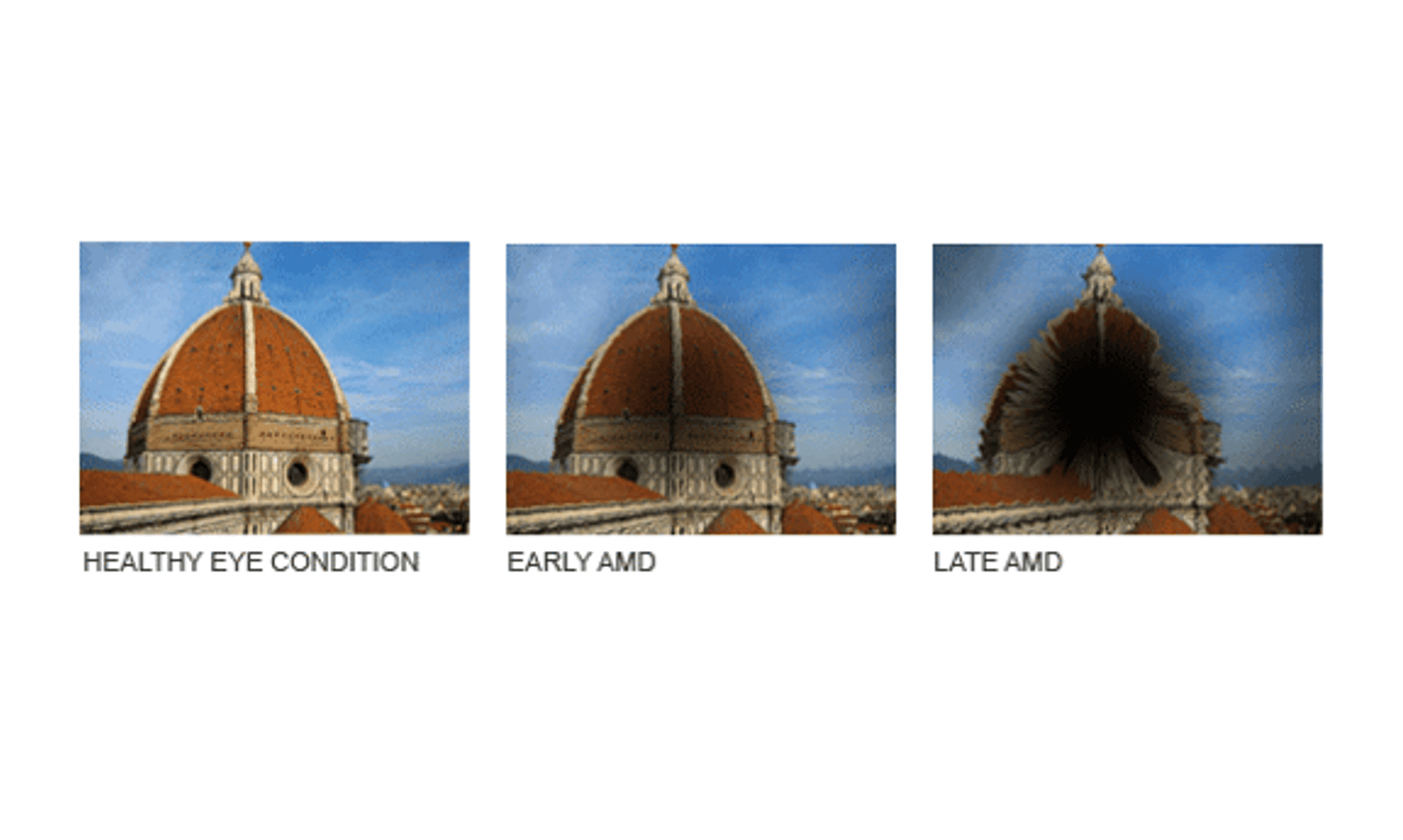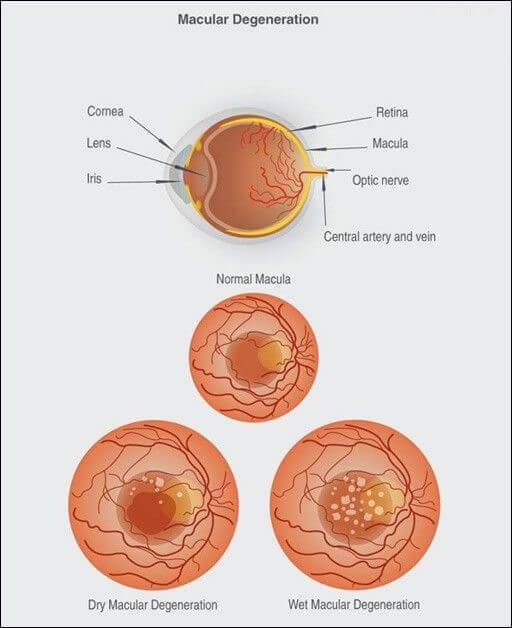by Kelly Davidson, expert from the Laser Eye Surgery Hub

Page contents
Age-related macular degeneration (AMD) is the leading cause of vision loss in people aged 60 and over. Even though it’s a painless condition, it will often affect both eyes, with sufferers losing their central vision. This means, when they’re looking straight ahead, their vision is blurred,. It means colours are less vibrant, reading is difficult and people’s faces become unrecognisable.
This loss of sight generally happens over a period of time, but some may find their eyesight deteriorates quickly. However, because AMD doesn’t affect the peripheral vision (side vision), complete blindness isn’t caused by this eye condition.
There are two types of macular degeneration – wet and dry:
Dry Age-Related Macular Degeneration (Dry AMD)
Around 9 out of 10 cases of AMD are dry AMD. This occurs when a buildup of deposits (drusen) damage cells in the macula. Compared to wet AMD, this is the least serious, because vision loss will happen gradually over a number of years. However, a tenth of all people who have dry AMD will go on to develop wet AMD.

When you suffer from dry AMD, it can take up to 5 or 10 years for your daily life to become affected by your loss of vision. Sometimes, if you have a healthy eye, this will compensate for your affected eye. This removes much of the vision loss or blurring. If this is the case, you might not notice the symptoms as quickly.
Other symptoms that indicate you may have dry AMD include:
- Text seems blurry
- You require a brighter light when you’re reading
- You struggle to recognise people’s faces
- Colours lose their vibrancy
- Your vision appears less defined or hazy
If any of these symptoms apply to you, you should make an appointment with your local optometrist or GP as soon as possible.
Wet Age-Related Macular Degeneration (Wet AMD)
Often referred to as neovascular AMD, wet AMD develops when cells are damaged underneath the macula due to the growth of abnormal blood vessels. This is more serious than dry AMD, and without treatment, your vision can deteriorate rapidly within a few days.
In a lot of cases, you’ll only develop wet AMD if you had dry AMD in the first place. However, if you have developed wet AMD you may notice that your central vision is getting worse.
Other symptoms include:
- Blind spots – you’ll often find these in the centre of your vision and they’ll get larger if they aren’t treated
- Visual distortions – e.g. when a straight line looks crooked or wavy
- Hallucinations – seeing animals, people or shapes that aren’t there
If you notice any of these symptoms, you should book an emergency appointment with your optometrist. If left untreated, wet AMD can severely affect your vision.
Due to the fact that AMD isn’t a painful condition, you might not notice you’re suffering from it until you experience some loss of vision.
Finding your central vision has become blurred is the main symptom of AMD. It means you’ve lost visual acuity and are unable to see the finer details. This makes driving and reading difficult. You’ll also lose contrast sensitivity, which affects your ability to distinguish things from a background, e.g. faces. You may also find that what you’re looking at becomes distorted in the centre. This is a symptom that’s more commonly associated with wet AMD.
You won’t notice a difference with your peripheral vision (side vision). Your blurred central vision cannot be corrected with glasses.
Even though it’s common for both of your eyes to be affected, you may start to notice AMD in one of your eyes first.
What causes Age-Related Macular Degeneration?
Even though it’s clear AMD develops as you get older, the exact cause of this eye condition still remains a mystery. Age-related macular degeneration occurs due to problems that arise in the macula, which is located in the centre of your retina. Providing sharp, central vision, the macula is constructed of millions of cells that are sensitive to the light. Therefore, when rays of light coming into your eye are focused here, it allows you to see things that are straight in front of you. The macula plays an important role in detailed, close-up activities, such as writing and reading.
Causes of Dry AMD
The light-sensitive cells of your macula can start to deteriorate as you get older. That’s why dry AMD normally develops over a number of years, as this deterioration will be gradual.
Within your retina, waste products may also start to gather, which form small deposits, also known as drusen. For dry AMD sufferers, drusen is a common problem, and, as the condition progresses, these waste particles tend to grow in size.
During the latter stages of dry AMD, your macula will have fewer light-sensitive cells, which is why you’ll notice a deterioration in your central vision. Often, you’ll find a blurred spot in the middle of your eye, which means your vision loses its definition. This means you may need more light when you’re carrying out close-up activities.
Causes of Wet AMD
In wet AMD cases, the macula is also affected, but this time it’s by tiny blood vessels that start to grow underneath it. Doctors believe these vessels start to form in a bid to clear away the waste (drusen) that’s accumulated on the retina.
However, these blood vessels aren’t growing in the right place, which is why they cause more harm than good. They can leak fluid and blood into your eye, which can damage your macula and cause scarring. And it’s this that results in the more serious side-effects of wet AMD, including blind spots and distorted vision.
What increases your risk of developing Age-Related Macular Degeneration?
As scientists are still unaware of what causes AMD, it’s difficult for them to pinpoint what triggers it. However, there are a number of contributing factors that can lead to you developing age-related macular degeneration, including:
- Age- The older you are, the more likely you are to develop AMD at some level. The majority of cases begin when someone’s aged 50+ with 1 in 10 having some signs of the condition by the time they’re over 65.
- Family History- AMD has been found in certain families. Therefore, if your sisters, brothers or parents develop AMD, you’re at a greater risk of developing it, too.
- This indicates that your increased risk of suffering from AMD is down to genes that have been passed on by your parents. However, it’s still unclear which genes are to blame and how these are passed through the generations.
- Smoking – When you smoke, you’re four times more likely to develop age-related macular degeneration than someone who doesn’t and never has.Your risk of developing AMD increases the longer you’ve been smoking for, and your risk is even higher if there’s a history of AMD in your family and you smoke.
- Ethnicity – Some studies have found that white and Chinese people are at the highest risk of developing AMD, with black people being at a lower risk. It is thought this could be due to genetics.
Additional Risk Factors
Even though these haven’t been proven as risk factors for AMD, there are some beliefs that they can increase your risk of developing the condition:
- Alcohol
- Sunlight
- Obesity
- Heart Disease and High Blood Pressure
Find a care home near you
Treatments for Macular Degeneration
Unfortunately, there is no cure for dry types of AMD at present although some evidence that vitamins may help. For wet AMD, Laser therapy (different to the laser eye surgery we mainly cover on this site ) can be used as well as anti-vascular endothelial growth factor (anti-VEGF) drugs which are injected.
Treating Dry AMD
Your vision may deteriorate very slowly when you have dry AMD, and you won’t suffer complete blindness as your peripheral vision (side vision) shouldn’t be affected.
Therefore, to make it easier for you to carry out day-to-day tasks, practical help may be beneficial, including large-print books, magnifying lenses, screen-reading software (which helps you use your computer) and very bright reading lights. To provide you with this support, you may be referred to a clinic that specialises in low vision cases.
Your Diet
Some evidence suggests that a diet high in lutein, zeaxanthin, and vitamins A, C and E may slow down how quickly dry AMD progresses – and it may also reduce your risk of developing wet AMD. (Your ophthalmologist should be able to advise whether these will be beneficial to you).
Foods that are rich in vitamins A, C and E include carrots, tomatoes, leafy green vegetables, kiwis and oranges. Leafy green veggies, as well as sweetcorn, mangoes and peas are also a great source of lutein.
Even though there’s no solid proof that these foods are an effective treatment for dry AMD, the benefits they offer your overall health are good, too.
Treating Wet AMD
There are two main treatments for wet AMD, which are:
Anti-VEGF Medication
Vascular endothelial growth factor (VEGF) is one of the chemicals responsible for new blood vessels growing in your eye, which is caused by this condition. To block this chemical, anti-VEGF drugs can be used, which will prevent these blood vessels from being produced, helping to stop your wet AMD from getting worse.
A very fine needle is used to inject this medication into your eye, and you will be administered with local anaesthetic eye drops before so it doesn’t hurt. A lot of people will find this procedure has minimal discomfort and can be tolerated quite well.
Sometimes, the blood vessels in your eye can be shrunk by anti-VEGF medication, which helps to restore some of the vision that’s been lost due to AMD. However, some might not see an improvement and vision cannot be restored completely.
Surgery
- Photodynamic Therapy -This involves injecting verteporfin (a light-sensitive medicine) into your arm. This attaches itself to the abnormal blood vessels that have grown in your macula. A low-powered laser is then used on the affected area, and the light from this activates the drug as it is absorbed by the verteporfin. This destroys the abnormal vessels, preventing them from leaking fluid or blood and causing further damage to your eye. Sometimes, this treatment may need carrying out every few months to make sure the new blood vessels that are growing are being controlled.
- Laser Photocoagulation- Some cases of wet AMD can be treated with laser photocoagulation, but this is only suitable if the abnormal blood vessels aren’t growing close to the fovea. Surgery in this area of the eye can cause permanent vision loss. Typically, 1 in 7 people are suitable for this operation in which a laser is used to burn away sections of your retina. This causes this area to harden, preventing any abnormal blood vessels from moving further along the macula.
To find out more about age-related macular degeneration go to https://www.lasereyesurgeryhub.co.uk/


